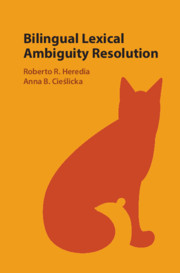Book contents
- Bilingual Lexical Ambiguity Resolution
- Bilingual Lexical Ambiguity Resolution
- Copyright page
- Dedication
- Contents
- Figures
- Tables
- Contributors
- Preface
- Acknowledgments
- Part I Theoretical and Methodological Considerations
- Part II Bilingual Lexical Processing
- Part III Bilingual Sentence Processing
- Part IV Neuroscience of Bilingual Lexical Access
- 9 Behavioral and Neural Correlates of Bilingual Lexical Ambiguity
- 10 Electrophysiology of Semantic Violations and Lexical Ambiguity Resolution in Bilingual Sentence Processing
- 11 Studying Bilingualism Through Eye-Tracking and Brain Imaging
- Author Index
- Subject Index
- References
9 - Behavioral and Neural Correlates of Bilingual Lexical Ambiguity
from Part IV - Neuroscience of Bilingual Lexical Access
Published online by Cambridge University Press: 24 December 2019
- Bilingual Lexical Ambiguity Resolution
- Bilingual Lexical Ambiguity Resolution
- Copyright page
- Dedication
- Contents
- Figures
- Tables
- Contributors
- Preface
- Acknowledgments
- Part I Theoretical and Methodological Considerations
- Part II Bilingual Lexical Processing
- Part III Bilingual Sentence Processing
- Part IV Neuroscience of Bilingual Lexical Access
- 9 Behavioral and Neural Correlates of Bilingual Lexical Ambiguity
- 10 Electrophysiology of Semantic Violations and Lexical Ambiguity Resolution in Bilingual Sentence Processing
- 11 Studying Bilingualism Through Eye-Tracking and Brain Imaging
- Author Index
- Subject Index
- References
Summary
This chapter elucidates the behavioral and neural underpinnings of bilingual lexical ambiguity processing during both first language (L1) and second language (L2) reading. It provides an overview of the eye-tracking and functional magnetic resonance imaging (fMRI) research on bilingual nonselective lexical access, as assessed through cognates, interlingual homographs, and cross-language orthographic neighbors (i.e., words that are lexically ambiguous across languages). Ultimately, the chapter demonstrates that eye movement patterns vary as a function of the nature and amount of cross-language overlap, as well as individual differences in L2 background and executive control capacity. It also demonstrates that left hemisphere brain regions implicated in executive functions (e.g., inferior frontal gyrus, dorsolateral prefrontal cortex, basal ganglia) are also implicated in resolving cross-language lexical ambiguity.
Keywords
- Type
- Chapter
- Information
- Bilingual Lexical Ambiguity Resolution , pp. 231 - 249Publisher: Cambridge University PressPrint publication year: 2020

